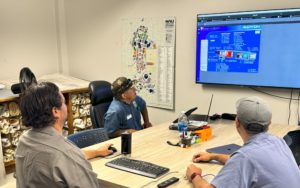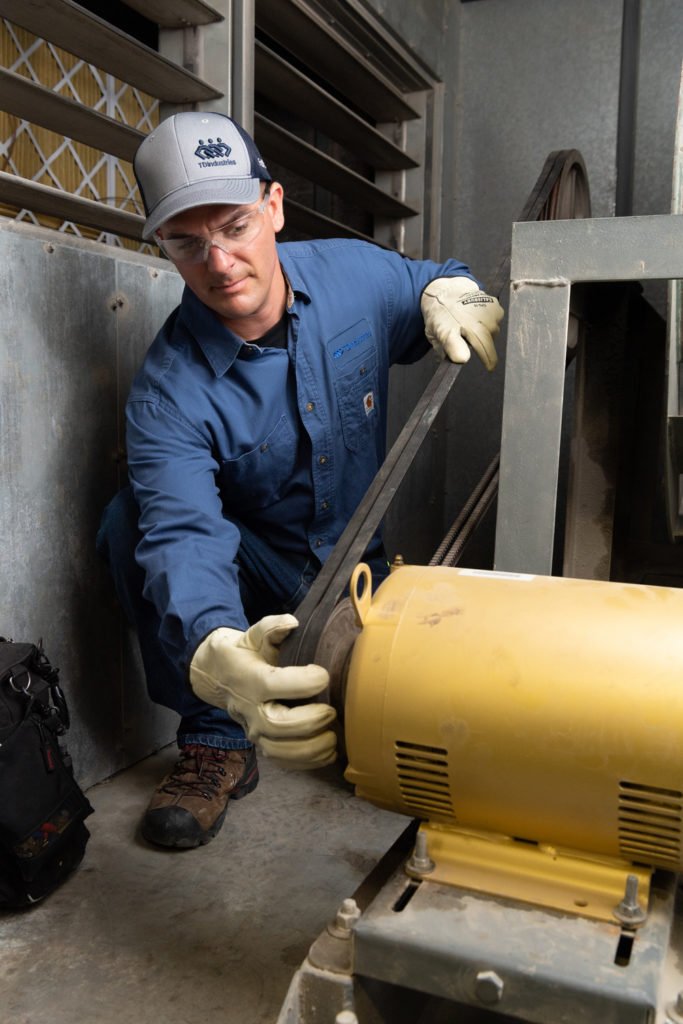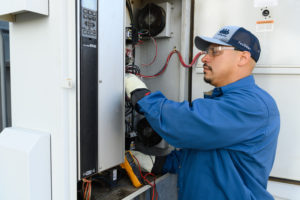Facility managers in every industry, including higher educational institutions, are grappling with the challenges posed by labor shortages and inflationary pressures. As operational leaders strive to keep their facilities in optimal condition, the task of recruiting and retaining top talent has become increasingly difficult.

The State of Facilities in Higher Education Report, 11th Edition. Photo Courtesy Gordian.
The scarcity of skilled trades workers presents a significant challenge. According to Gordian’s State of Facilities in Higher Education 2024 report, higher education facilities leaders say that finding talented trades workers is their greatest challenge, and without fully skilled and staffed facilities teams, the properties age more quickly. Since 2007, the maintenance trades have experienced a coverage area increase of nearly 25 percent, now covering nearly 106,000 gross square feet.
In a January Gordian survey, 61 percent of respondents said they faced vacancies in more than five percent of their staff positions. Furthermore, Facilities teams compete for skilled talent with the construction industry, which faces an imminent need to hire nearly one million additional people— over and above regular hiring rates—just to meet demand through 2025, according to Associated Builders and Contractors (ABC).
The gap in skilled tradespeople adds another layer of complexity to the difficulties confronting today’s facility managers. As most hiring managers know, many experienced employees are nearing retirement age while new technicians in the pipeline are still honing their skills. In recent decades, high school students have been more inclined to pursue a college degree than vocational training, leaving a generational shortage of mission-critical workers.
How Three Schools Resolved Their Facilities Management Staffing Challenges
In an era where effective facilities management is critical to supporting academic excellence, institutions continually seek innovative approaches to address staffing challenges and optimize operational efficiency.
In this article, we’ll illustrate three case studies of universities that exemplify creativity by leveraging unique strategies tailored to their specific needs. From substituting on-demand facilities management with on-site supplemental staffing to experimenting with proof of concepts to leveraging buying groups for faster implementation, these institutions are at the forefront of reshaping the landscape of facilities management in higher education.
1. Substitute On-Demand Facilities Management with On-Site Supplemental Staffing

The Northern Arizona University campus in Flagstaff, Arizona. Photo licensed by TDIndustries from Adobe Stock.
Northern Arizona University ranks among the National Science Foundation’s top 100 in the nation for public institutions without a medical school. With 176 academic and residential buildings and more than seven million square feet of facilities to manage, the school was challenged to acquire and retain enough HVAC technicians to keep up with the needs of its substantial campus. With the backlog of work continuing to climb, NAU’s operations team released a request for a proposal for on-demand HVAC repair and maintenance services.
As the bids were incoming, the associate vice president of facilities services recognized an opportunity to take an alternative approach to staffing with a supplemental Facilities Management Program customized for their exact needs. The winning custom contract included supplemental crew members to work alongside existing NAU staff. Reporting to the campus facilities services team, one manager and several technicians would be on-site, augmenting the existing crew and helping this higher education institution meet its HVAC staffing requirements.
With the fall semester quickly approaching, the combined crew faced a backlog of open work orders and some systems down. The team needed to catch up quickly to ensure students could return to a safe and healthy environment that fostered the highest learning potential. A quick start team was put into place by the contractor who immediately brought in team members from other states to start working on open work orders.

NAU’s Facilities Director meets with contract Facilities Manager II Aaron Altenbaugh. Photo ©2024 Bryan Urton.
Meanwhile, recruiters went to work on hiring the most skilled technicians to fill the open roles. Among the many advantages of supplemental staffing is adding personnel without the burdens of recruiting, training, and retention. The university isn’t tasked with providing employee benefits and compensation for new team members, but they still get the much-needed resources to complete the work at hand.
Even more resources were made available by including the use of capital equipment within the contract. Tools, repair equipment, and service vehicles are supplied by the supplemental contract, leaving more room in the budget for actual maintenance and service costs.
Critical work orders were under control within six months, with week-by-week noticeable improvement in operational efficiency, when the quick start team was able to address comfort and efficiency issues immediately.
Using the existing computerized maintenance management system (CMMS), more than 3,200 preventative maintenance (PM) and corrective work orders were completed in the second year of this multi-year custom contract, which assumed various HVAC responsibilities from other shops, allowing those trades to focus their efforts on their shop-specific priorities.

NAU technicians work with the supplemental team. Photo ©2024 Bryan Urton.
The contract also included regular after-hours rotation, so the university’s technicians no longer have to be on call every other week. Today, a new preventative maintenance program is in place, along with new, procedural-driven process enhancements and the continued pursuit and achievement of operational excellence.
While an embedded partnership wasn’t originally on the university’s radar, ignoring the upstream and downstream benefits was impossible. Approximately $200,000 in cost avoidance was realized in the second year alone. A 50 percent increase in productivity, a 25 percent reduced response time, and a 43 percent reduction in the cost per work order.
The in-house and supplemental staff work well together, and the potential to roll out similar partnerships in other areas is being considered.
2. Experiment with a Facilities Management Proof of Concept
Listed among the top 50 United States higher education facilities by QS World University Rankings 2024, this large regional university in the Southwest prides itself on a heritage of excellence and a pristine campus to support the students’ experiences and ensure their success. The university was staffed for most of its skilled trades functions. But, like many others, it struggled to fill open HVAC technician roles. Facilities management (FM) was forced to rely on other trades to troubleshoot HVAC issues and repair what they could while contracting out most of the work to on-demand providers. Knowing this was not sustainable due to costs and response times, the institution sought alternative solutions.

Belt replacements were among the critical tasks completed within a few months of the contract start. Photo ©2024 Kevin Brown.
To staff its HVAC shops, the school required one new Level III Technician to troubleshoot and identify needed repairs in each of its three campus zones. Work would then be passed on to Level II Technicians per zone. Retaining control of its FM team and operations, all staff would report to an assigned zone manager employed by the college.
The university decided to partner with a contractor on a pilot program that covered a single zone encompassing 56 academic buildings. This proof of concept allowed the university to see if the supplemental partnership would work well for its existing staff and workload while reducing operational costs.
A custom corrective maintenance contract embedded new technicians within the assigned zone. Approximately 5,000 backlogged work orders were prioritized, including repairs and deferred maintenance. Within the first five months, the supplemental team completed critical tasks, such as motor replacements, a Lovejoy replacement, and belt replacements, to keep the HVAC equipment operating correctly and extend its life. Going above and beyond, the staff also replaced floor tiles in a wet zone to ensure sufficient drainage and assisted with fire cleanup.
Entering the second half of the one-year pilot contract, there has been sufficient cost avoidance to allow the hiring of additional Level II Technicians to help with the upcoming change of seasons. In addition to corrective maintenance and technical PM, the contract balance will focus on upskilling, establishing standardized workflow procedures, improving reporting, and creating capital planning documentation. With a full staff that has made significant progress on clearing the backlog and enabling value-added services—while still leaving the budget for additional staff—this proof of concept is already demonstrating successes worthy of expanding to the remaining zones.
3. Leverage Buying Groups for Faster Implementation
Recognized as a Community College of Excellence by The Aspen Institute for three consecutive years, this Arizona community college is known for its high quality, accessible educational opportunities, innovative teaching, and support services. This higher learning establishment decided to leverage a cooperative purchasing agreement with a cooperative buying group that solicits bids on a variety of products and services that public agencies often need and use, thereby avoiding lengthy procurement times for contracting with new vendors. These companies do all the legwork required to validate a contractor. They gather all the qualitative criteria and typically get more competitive pricing than buying direct.

Seasoned HVAC professionals help fill higher education facilities skills gaps. Photo ©2024 Kevin Brown
These procurement groups create master buying agreements that their members can utilize to acquire resources without the bureaucratic hurdles of direct contracts. Billing and day-to-day activity are generally still controlled by the college or university, but the contract is between the buying group and the contractor. A very attractive option for educational facilities seeking support, many districts can piggyback on the purchase cooperative agreements already approved by other states.
This college initially needed to fill open roles for a Level III Technician and Level II Technicians on its HVAC team. The crew would handle all corrective and PM work orders and support the plumbing shop, which was also short-staffed. With one of its highly skilled HVAC techs retiring soon, replacing that person with equivalent talent was of utmost importance. Having trouble finding the proper skillset and knowing they needed to act quickly, the university chose a custom supplemental facilities management agreement through the buying group they selected. Six months into the partnership, it is estimated that a 22% reduction in corrective work completion time was achieved, with $19,000 in cost avoidance.
Tips for Implementing Alternative Facilities Management Solutions
Getting started with innovative approaches requires some planning and strategic implementation. To initiate similar initiatives for your institution, consider the following:
- Assess Current Challenges: Conduct a thorough assessment of your facilities management needs, including labor shortages, budget constraints, capital requirements, backlogs, and operational inefficiencies.
- Research Best Practices: Contact facilities management contractors for input on successful approaches utilized by institutions facing similar challenges.
- Develop a Strategy: Create a comprehensive strategy tailored to your specific challenges. Define clear goals, objectives, and key performance indicators (KPI) to measure the success of your initiatives.
- Search for a Qualified Integrated Facilities Management Contractor: Look for service providers with expertise, safety, and culture that align with your own. It’s imperative that you get skilled technicians and people who can assimilate well and work as a team.
- Communication is Key: Establish expectations for giving and receiving feedback on your FM program. You want to work with a contractor with a reputation for integrity, partnership, and interaction.
- Evaluate Results: Continuously monitor the progress of your programs, collecting data on cost savings, productivity improvements, and occupant satisfaction. Use this feedback to refine and adjust your strategy as needed.
As the landscape of facilities management continues to evolve, it’s clear that collaboration, flexibility, and forward-thinking strategies will be the key to success. These narratives highlight the transformative power of strategic partnerships and adaptive solutions in overcoming obstacles and driving tangible outcomes for campuses nationwide.
Bryan Urton is facilities manager III at TDIndustries in Phoenix, Arizona. He can be reached at [email protected]. Mic Sternard is senior facilities director at TDIndustries in Phoenix, Arizona. He can be reached at [email protected]. This is their first article for Facilities Manager.



